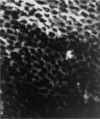Effect of bleaching agents on enamel surface of bovine teeth: A SEM study
- PMID: 28149462
- PMCID: PMC5268116
- DOI: 10.4317/jced.53011
Effect of bleaching agents on enamel surface of bovine teeth: A SEM study
Abstract
Background: This study aimed to evaluate changes in the enamel surface of bovine teeth after whitening with exogenous bleaching agents: 10% carbamide peroxide (group 1), 16% carbamide peroxide (group 2) and 35% hydrogen peroxide activated by a light-emitting diode (LED) (group 3). The evaluations were performed by scanning electron microscopy (SEM).
Material and methods: Ninety bovine teeth were divided into five groups (n = 18). The bleaching agents 10% and 16% carbamide peroxide were applied for eight hours a day for 14 consecutive days. The third agent, LED-activated 35% hydrogen peroxide, was used four times at seven-day intervals. Each of the four time points consisted of three applications of 10 minutes each. A 37% phosphoric acid solution and artificial saliva were used as positive and negative controls, respectively.
Results: The evaluations by SEM showed changes in the enamel surfaces of the specimens. Based on the Mann-Whitney statistical test, the data showed significant differences (p<0.05) between groups 1 and 2 and between groups 2 and 3. However, no significant difference (p>0.05) was observed between groups 1 and 3.
Conclusions: Based on these results, it can be concluded that bleaching agents can cause changes in the structure of tooth enamel and that these changes are related to the concentration and the duration of contact with the tooth surface. Key words:Bovine teeth, carbamide peroxide, enamel, hydrogen peroxide, scanning electronic microscopy.
Conflict of interest statement
The authors deny any conflicts of interest.
Figures
Similar articles
-
Effect of carbamide peroxide bleaching on enamel characteristics and susceptibility to further discoloration.J Prosthet Dent. 2019 Feb;121(2):340-346. doi: 10.1016/j.prosdent.2018.03.006. Epub 2018 Aug 20. J Prosthet Dent. 2019. PMID: 30139674 Free PMC article.
-
Effect of 16% Carbamide Peroxide and Activated-Charcoal-Based Whitening Toothpaste on Enamel Surface Roughness in Bovine Teeth: An In Vitro Study.Biomedicines. 2022 Dec 22;11(1):22. doi: 10.3390/biomedicines11010022. Biomedicines. 2022. PMID: 36672530 Free PMC article.
-
Scanning electron microscopy study of dental enamel surface exposed to 35% hydrogen peroxide: alone, with saliva, and with 10% carbamide peroxide.J Esthet Restor Dent. 2003;15(3):154-64; discussion 165. doi: 10.1111/j.1708-8240.2003.tb00185.x. J Esthet Restor Dent. 2003. PMID: 12859113
-
In Vitro Evaluation of the Effectiveness of Dental Bleaching with Carbamide Peroxide and Violet Light.Photobiomodul Photomed Laser Surg. 2021 Aug;39(8):535-543. doi: 10.1089/photob.2020.4824. Epub 2021 Aug 2. Photobiomodul Photomed Laser Surg. 2021. PMID: 34342514
-
Effect of Bleaching Agents on Healthy Enamel, White Spots, and Carious Lesions: A Systematic Review and Meta-Analysis.Dent J (Basel). 2024 May 11;12(5):140. doi: 10.3390/dj12050140. Dent J (Basel). 2024. PMID: 38786538 Free PMC article. Review.
Cited by
-
The Effect of In-Office Bleaching with Different Concentrations of Hydrogen Peroxide on Enamel Color, Roughness, and Color Stability.Materials (Basel). 2023 Feb 7;16(4):1389. doi: 10.3390/ma16041389. Materials (Basel). 2023. PMID: 36837018 Free PMC article.
-
Effect of home and in-office bleaching systems on the nanomechanical properties of tooth enamel.Saudi Dent J. 2020 Nov;32(7):343-348. doi: 10.1016/j.sdentj.2019.10.007. Epub 2019 Nov 6. Saudi Dent J. 2020. PMID: 33132662 Free PMC article.
-
Influence of different alcohol intake frequencies on alveolar bone loss in adult rats: A sem study.J Clin Exp Dent. 2018 Sep 1;10(9):e852-e857. doi: 10.4317/jced.54647. eCollection 2018 Sep. J Clin Exp Dent. 2018. PMID: 30386516 Free PMC article.
-
In vitro comparison of an Er:YAG laser-activated bleaching system with different light-activated bleaching systems for color change, surface roughness, and enamel bond strength.Lasers Med Sci. 2018 Dec;33(9):1913-1918. doi: 10.1007/s10103-018-2555-0. Epub 2018 Jun 2. Lasers Med Sci. 2018. PMID: 29860663
-
Effects of Amorphous Calcium Phosphate Administration on Dental Sensitivity during In-Office and At-Home Interventions.Dent J (Basel). 2018 Oct 1;6(4):52. doi: 10.3390/dj6040052. Dent J (Basel). 2018. PMID: 30275415 Free PMC article.
References
-
- Haywood VB, Heymann HO. Nightguard vital bleaching. Quintessence Int. 1989;20:173–6. - PubMed
-
- Lopes GC, Bonissoni L, Baratieri LN, Vieira LC, Monteiro S Jr. Effect of bleaching agents on the hardness and morphology of enamel. J Esthet Restor Dent. 2002;14:24–30. - PubMed
-
- Basting RT, Rodrigues AL, Serra MC. The effect of 10% carbamide peroxide, carbopol and/or glycerin on enamel and dentin microhardness. Oper Dent. 2005;30:608–16. - PubMed
-
- Kaur D, Vishwanath, Jayalakshmi KB. Effect of various Nightguard vital bleaching agents on surface morphology of enamel - a SEM study. Endodontol. 2003;15:2–6.
-
- Baik JW, Rueggeberg FA, Liewehr FR. Effect of light-enhanced bleaching on in vitro surface and intrapulpal temperature rise. J Esthet Restor Dent. 2001;13:370–8. - PubMed
LinkOut - more resources
Full Text Sources
Other Literature Sources



